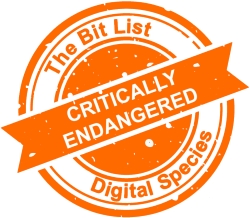Non-current Portable Magnetic Media
 |
||
|
Materials saved to floppy disks, tape, portable hard disks or other numerous magnetic storage devices where the media is out of warranty and reader devices may no longer be supported or integrated easily into hardware infrastructure: typically, more than five years old. |
||
|
Digital Species: Portable Media |
Trend in 2022:
|
Consensus Decision |
|
Added to List: 2019 |
Trend in 2023:
|
Previously: Critically Endangered |
|
Imminence of Action Action is recommended within three years, detailed assessment within one year. |
Significance of Loss The loss of tools, data or services within this group would impact on people and sectors around the world. |
Effort to Preserve | Inevitability It would require a major effort to prevent or reduce losses in this group, possibly requiring the development of new preservation tools or techniques. |
|
Examples Floppy disks; tape; certain kinds of portable hard disks, zip drives. |
||
|
‘Practically Extinct’ in the Presence of Aggravating Conditions Poor storage; inability to access readers; no replication; encryption; aggressive compression. |
||
|
‘Endangered’ in the Presence of Good Practice Active management; dependable access to readers; strong documentation; documentation independent from the media. |
||
|
2023 Review The 2019 Jury introduced this entry to ensure that the range of media storage is properly assessed and presented. Portable magnetic media is ubiquitous but is fragile not just to physical wear and tear but also to magnetic interference and bit-rot. The substrates of the disks can prove unstable, and in some cases, proprietary reader technology means that the disk becomes obsolete before it degrades. Storage at scale also means the percentage likelihood of failure increases. The 2021 Jury agreed with the entry’s assigned risk classification with no noted changes towards increased or reduced risk. The 2023 Council agreed with the risk classification of Critically Endangered with the overall risks remaining on the same basis as before (no change to the trend). Additionally, a new entry “Non-current Rare Portable Magnetic Media” was created as a split, related standalone entry to highlight the increased risk. |
||
|
Additional Comments There is no "active management" of data found on these media items. The data should be copied off of the media and into a digital preservation system that allows for active management. Data found on these media should be considered a backup, at best. We know what to do with this type of material, it is the scale that makes it a problem. There is really no excuse for using floppy disks for storage these days. Tape is a different proposition since it allows high-density back up offline and nearline. But there are challenges with the backward compatibility of popular and even relatively recent LTO versions. Case Studies or Examples:
|
||






























































































































